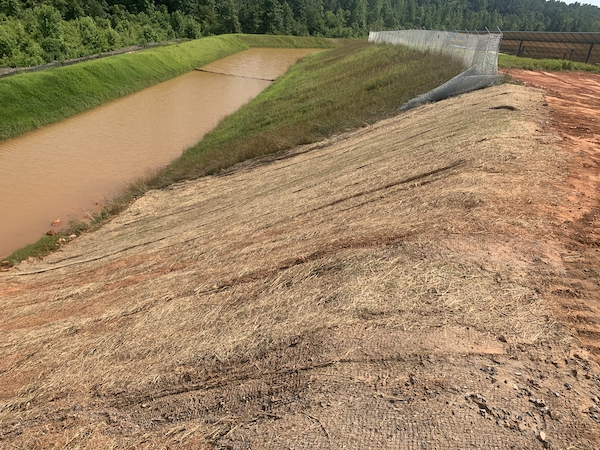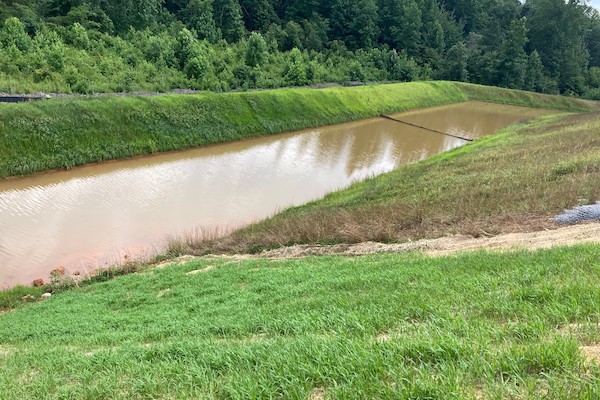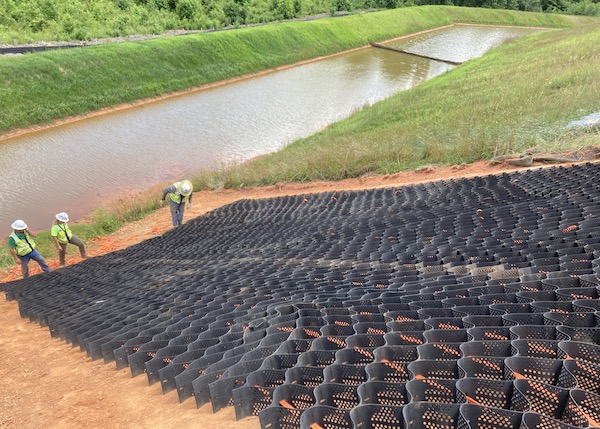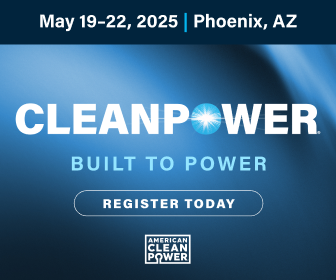Keeping Hillside Solar from Washing Away How geocell-stabilized slope provides permanent erosion control solution at solar farm
Although the solar industry has enjoyed an average annual growth rate of 42 percent since 2010, it continues to face challenges when it comes to the construction and operation of solar farms. In addition to factors like trackers, panels, and grid tie-in, designers must also account for erosion control and stormwater management. Investing in smart civil site design will ensure long-term project success.
Such was the case at a Virginia-based photovoltaic power station, which also happens to be one of the largest utility-scale solar sites east of the Rockies. The project site spans approximately 3,500 acres designated for power generation, with an additional 2,000 acres preserved as undeveloped, conserved land. The original project design will support the generation of enough power to supply the equivalent of approximately 111,000 homes, offsetting 340,000 tons of carbon dioxide emissions each year. It is, therefore, not surprising that a project of this scope posed some unique site development challenges that required economical, long-term solutions to keep construction on schedule and within the project budget
 The Challenge: Stabilizing a Slope Vulnerable to Erosion
The Challenge: Stabilizing a Slope Vulnerable to Erosion
Stormwater runoff is a concern during the development and operation of many solar farms, especially large-scale operations like the Virginia site. To meet local stormwater regulations, the project design required the construction of hundreds of retention ponds. The site included a steeply sloped area that led into one of the larger detention ponds. Due to its location, it had to withstand concentrated runoff volumes; this required a permanent stabilization solution to protect the slope surface from excessive rilling and the damaging effects of erosion.
Located at the back of the site, the 2:1 slope that extended down into the stormwater pond was already experiencing severe erosion. The location of the slope - next to an access road and downslope from a solar array - meant that, despite multiple efforts to stabilize the slope surface, traditional erosion control strategies were unsuccessful.
The civil site design included a gradual decline over approximately 23 acres to the pond slope. Because of this, the slope’s surface had to support a large volume of concentrated flow, with the neighboring access road causing the flow to gain velocity as it approached the area. Stone check dams and other traditional erosion and sediment control practices were not feasible because they would block the access road, which was needed for construction.
Conventional Erosion Control Methods Fail to Stabilize Slope Surface
Initial efforts to stabilize the slope surface included hydroseeding and covering with a single-net straw matting; however, this system eventually failed. Subsequent efforts included the installation of straw-coconut matting over the slope surface, which also failed. After the second attempt was unsuccessful, a tri-net turf reinforcement mat (TRM) was placed on the slope, but this failed due to runoff undermining the anchor trench next to the access road.
The large volume of runoff was getting under the TRM, creating soil loss and causing large gullies to form. The contractor evaluated riprap, articulated concrete blankets, and a geocellular system to solve the issue permanently.
The Solution: A Vegetated Geocell-Stabilized Slope
The contractor finally selected a geocellular system to stabilize the slope, citing cost and performance as the major determining factors. The perforations in the cell walls of the geocell system allow water to flow throughout the system once it reaches the area below the anchor trench. Meanwhile, the cell walls provide confinement, thereby protecting against soil loss and the formation of rills and gullies that resulted with the use of a TRM.
Another significant advantage that contributed to the final decision to use a geocell system .jpg) was the ability to use on-site fill. Not surprisingly, the ability to use on-site material often amounts to considerable overall project cost savings. Moreover, solar projects are often Net Zero sites that prohibit the use of imported fill.
was the ability to use on-site fill. Not surprisingly, the ability to use on-site material often amounts to considerable overall project cost savings. Moreover, solar projects are often Net Zero sites that prohibit the use of imported fill.
The geocellular system (6-inch cell depth) was installed directly over the 2:1 slope and secured using woven polyester tendons (5,100 lb. break strength). The tendons extended downslope through the geocell panels ,and were affixed to the cell walls using specialized tendon clips that act as a load transfer device. At the top of the slope, the tendons were fastened to a buried deadman pipe to permanently anchor the system in place.
After geocell installation, the slope was hydroseeded and covered with a straw-coconut erosion control blanket. The completed system provides a structurally stable environment for topsoil and sustainable vegetation to grow. The roots become intertwined and entangled with the perforated cell walls and interconnected network of discrete cells, and the system’s overall resistance to erosive and sliding forces increases as the vegetated surface grows and matures into an established ground cover.
Project Results
To date, the vegetated slope has held up to multiple high-intensity rain events without any slope failures or gully erosion formation. Once the system was installed, and the area was seeded and matted, the slope immediately began to show vegetation. Given the size of the slope and the amount of runoff directed to the area, the geocell system is performing better than anticipated.

How Do Geocells Work to Stabilize Soils?
Through an interconnected honeycomb-like network, geocells confine and stabilize soils that would otherwise be unstable under loading or when subjected to erosive forces. Geocells are an efficient and economical solution for fast-built unpaved roadways and retaining walls, protection of steep and complex slopes, and stormwater control in channels.
Michael J. Dickey, P.E., is Director at Presto Geosystems—one of the early pioneers in the world of geosynthetics and manufacturer of geocell soil confinement solutions.
Presto Geosystems | www.prestogeo.com
Author: Michael J. Dickey, P.E.
Volume: 2022 November/December












.png?r=4447)